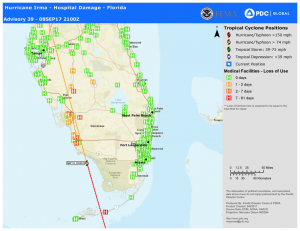Pacific Disaster Center supports life-saving decisions in Florida as Hurricane Irma moves
University of HawaiʻiCommunications and Outreach Manager, Pacific Disaster Center
Kelli Abe Trifonovitch, (808) 228-8108
Director of Communications and Outreach, University of Hawai‘i System
Kihei, HI—Hurricane Irma strengthened and is expected to strike South Florida and the Keys on Sunday. Working with local, state and federal emergency managers, the science advisors and disaster response experts at the Pacific Disaster Center (PDC) express grave concern about its potential devastation. The University of Hawai‘i applied research center, is working around the clock with FEMA and Florida Emergency Management professionals to help analyze impacts and make sure the most vulnerable populations are protected. Although the eye of Irma has shifted west of Miami-Dade, PDC’s Senior Science Advisor and former senior physical scientist at FEMA Doug Bausch,says Irma remains “one of the most potentially destructive hurricanes observed through modeled data” in his 20-year career.
Describing the many ways the PDC is being leveraged by FEMA and Florida emergency managers to help make life-saving decisions, Joseph Green, epidemiologist and health risk specialist said, “Our DisasterAWARE technology and team of experts provide critical information to disaster managers to help them execute plans to protect not just everyday residents and business, but the most vulnerable people in society such as those residing in the care of hospitals.” He said Florida’s Division of Emergency Management has so far evacuated 17 hospitals and 196 non-hospital healthcare facilities in coordination with the Florida Department of Health. Similarly, DisasterAWARE is helping emergency managers anticipate the needs of other vulnerable populations including people with disabilities and those in underserved communities.
A strategic partner of PDC in disaster management science, Georgetown University associate professor and faculty director of the emergency and disaster management program, Tim Frazier, said, “What PDC has developed with its DisasterAWARE technology is a significant scientific advancement for the modeling of hazard exposures and population impacts.” He explained that, “while others have created prototypes to assess impacts for specific regions, PDC has fully implemented the technology, on a global scale, to be used worldwide in disaster management decision support and disaster risk reduction.”
PDC is using DisasterAWARE, along with its many partners, to support planning, response and recovery for Irma while also supporting our partners in Texas as they continue to deal with Hurricane Harvey and its record-breaking rainfall of just days ago. The use of technology has allowed the small staff at PDC to support these and the countless disasters happening around the world – including the magnitude 8.1 earthquake that struck off the coast of Mexico last night.
PDC Director of Disaster Services Erin Hughey said, “We have activated a 24-hour support team to help deal with the requests for data and information from our partners and the public as the country braces for impact. We are also closely monitoring Hurricanes Jose (Category 4) and Katia (Category 3).” She said, “Now, more than ever, agencies are depending on the capabilities of the PDC and its DisasterAWARE technology.”
For more information about Pacific Disaster Center, and to follow its situational analyses as these extremely dangerous hazards unfold, http://www.pdc.org/event-dashboard/2017_Hurricane_Irma.


